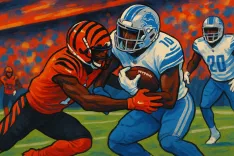Key Fantasy Football Players to Avoid in 2025

As fantasy football managers prepare for the 2025 NFL season, many will enter their draft rooms with specific players they intend to target. However, it is equally important for managers to consider which players to avoid at their typical draft cost. While securing a potential league-winner can significantly enhance a team's prospects, successfully steering clear of early-round disappointments is similarly crucial for overall success. Given that attrition tends to impact running backs the most, it is pertinent to focus on three players at this essential position who exhibit several warning signs that may not justify their elevated draft prices.
Christian McCaffrey's potential remains both obvious and intriguing. If he can stay healthy for an entire season, he could emerge as one of the top players in fantasy football. That said, the caveat of 'if healthy' is particularly relevant for McCaffrey, who has been limited to seven games or fewer in three of the last five seasons, including just four appearances in 2024 and three in 2020. With his next birthday marking his 30th year, a milestone age that often raises concerns for running backs, McCaffrey’s performance last season was notably less effective. Although his playing time was limited, when he was on the field, he averaged only 5.4 yards per touch, the second-fewest of his career, and he failed to score for the first time in his professional tenure. The significant potential he represents is difficult to overlook, yet it seems concerning for fantasy managers to gamble on his recovery and performance at a first-round draft cost.
Javonte Williams presents an interesting case as well. Last season, only five running backs scored more standard fantasy points than Williams, which might seem encouraging at first glance. However, a closer examination reveals that he transformed a considerable opportunity volume into merely good production numbers. The question arises: what happens to his performance if those opportunities decrease? Williams provided the Los Angeles Rams with several reasons to rethink their offensive strategy. After averaging an impressive 4.7 yards per touch in his first two years, he experienced a drop to a career-low 4.2 yards per touch last season. Although the Rams have not heavily invested in backup running backs and recently extended Williams' contract, they may still seek a more effective rushing option, especially since he has not consistently generated explosive plays. Should Williams' production take a downturn, selecting him at a late second- or early third-round pick could prove to be a risky investment.
Finally, Breece Hall’s performance raises questions as well. While a 1,000-yard rushing season is a significant achievement for any running back, it becomes less impressive when considering that, in a full 17-game schedule, a player only needs to average just under 60 rushing yards per game to reach that milestone. This context is particularly relevant for Hall, as he has yet to experience a 1,000-yard rushing season or a double-digit touchdown campaign. Some analysts assert that Hall adds value with his effectiveness in the passing game; however, doubts emerge regarding his potential efficiency as a receiver given that he will be receiving passes from Justin Fields. Fields, with a career completion percentage of only 61.1 percent and more games played than touchdowns thrown, raises concerns. Furthermore, Fields' effectiveness as a runner may limit Hall's rushing opportunities. Compounding this issue, Jets coach Aaron Glenn has indicated a desire to implement a by-committee approach with the running backs, suggesting that Hall's volume may not meet expectations. This is particularly pertinent considering Hall's current average draft cost in the third round.









